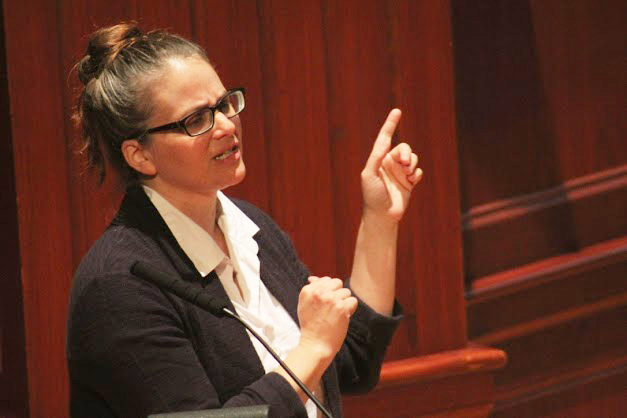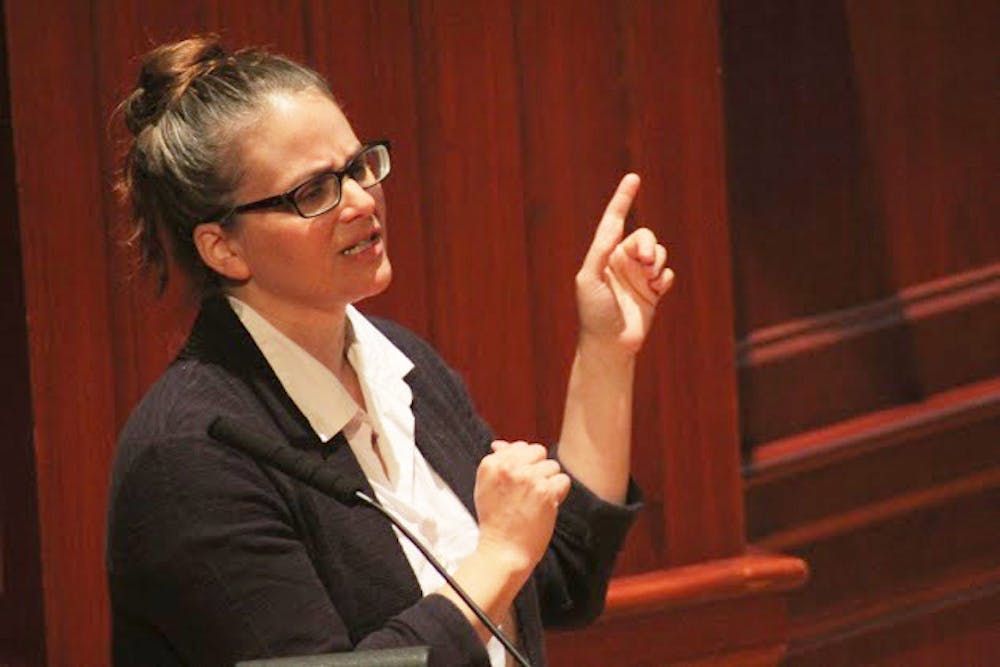By Kelly Vena
Correspondent
No one was allowed to sit in the back rows of Mayo Concert Hall for Kate Gilmore’s presentation during the first Visiting Artist Series of the semester on Wednesday, Oct. 28.
“I like to make my lectures interactive so you all don’t get sick of hearing my voice,” Gilmore said as she encouraged students to migrate toward the front rows. “I put some responsibility on the audience, as well as myself, to make it more interesting.”
Gilmore, a Washington, D.C., native who now resides in New York City, is a renowned artist whose work centers around challenging a gender-biased society. She has received numerous awards for her pieces, including the Artist Space Independent Project Grant in 2003 and the 2010 Lower Manhattan Cultural Council Award for Artistic Excellence.

Despite her accolades, Gilmore did not take her first art class until college.
“I fell in love with art. It makes me feel comfortable in my own skin and is the best way for me to communicate to the world,” she said with a smile.
Gilmore attended Bates College, a small liberal arts college in Lewiston, Maine. She graduated in 1997 as an art and European history double major.
After graduating from Bates, Gilmore decided to take a few years off before continuing on to graduate school.
“I worked with autistic kids,” she said. “I taught them how to use art as an outlet.”
Gilmore eventually went to grad school at the School of Visual Arts, in Manhattan. She described her grad school experience as “doing a ton of work, then having a ton of people come into your studio to critique it.”
When she first began her career in art, Gilmore started with traditional sculpture and pottery, using common materials such as cement and sheetrock. Although she put hours of time into her work, Gilmore realized people were more interested in her personality and processes than her actual work.
“My ideas weren’t coming through in my work,” she said. “That was when it dawned on me that labor does not equal worth.”
It was the second semester of her second year of grad school when Gilmore discovered video as a medium for her art. A self-described “performance, video, installation artist-person,” this discovery greatly impacted her artistic career. In her earlier video works, Gilmore would dress up as prominent female figures such as Hillary Clinton and Martha Stewart, and have them react to the unconventional environments she would create.
“I recreated Ted Kaczynski’s (the Unabomber’s) hut, dressed up as Martha Stewart, and had her reorganizing it,” Gilmore said of one of her early videos.
Gilmore uses her early works, as well as her more recent ones, to depict women reacting to the environments around them. Just a few months after the 9/11 terrorist attacks, she dressed as Clinton for yet another video.
“In this one, Hillary is hanging a chandelier when suddenly the floor begins to break underneath her. She has to try and maintain her balance and not fall,” Gilmore said.
The video was a reaction to the terrorist attacks, and Clinton served as a symbol for the United States struggling to recover from the sudden and devastating plane crashes.
Instead of describing her pieces to the audience, Gilmore decided to show the actual footage. In her video “My Love is an Anchor,” made in 2004, Gilmore is wearing a black dress and stockings as she attempts to remove her leg from a bucket of plaster.
“My foot was stuck in there for, like, two hours!” Gilmore exclaimed as the video of her struggling enraptured the audience.
Another piece, “Buster,” which was made in 2011, depicts Gilmore as she breaks 220 ceramic pots one by one.
Although her video creations vary greatly, they all include elements of color.
“The color in each video is used consciously,” Gilmore said. “They’re all girly, super-bright, technicolor, clown colors. Colorful pieces are often rejected in the art world. Rejecting feminine, colorful art rejects the majority of artwork.”
She hopes her unconventional use of color contributes to a revolution of the art world’s opinion of colorful pieces.
After her presentation, Gilmore opened the floor for a question and answer session, and one student asked about her creative process.
“It is important for people to have a diverse understanding of the world to create art,” she told the audience. “A diverse education, different readings, meeting different people, personal experiences — I believe your work becomes better with those things.”







